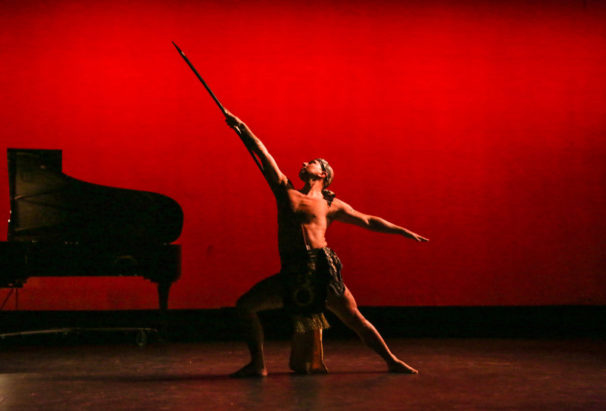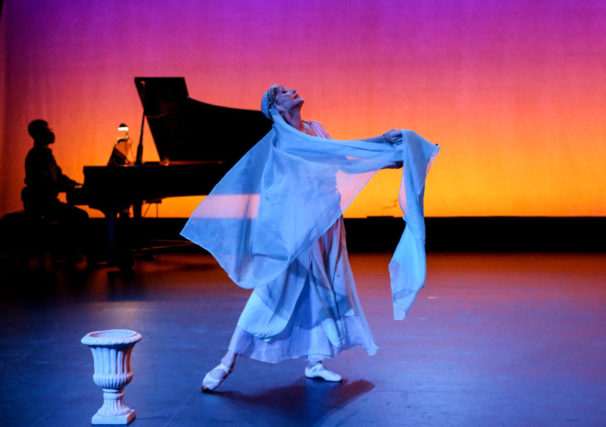DANCES BY RUTH ST. DENIS & TED SHAWN
September 30 – October 3, 2021
The Theatre at St. Jean’s 150 East 76th St, New York City

photo Julie Lemberger
Of the eloquent, elegantly presented sampling of choreography by Ruth St. Denis and Ted Shawn on view in a special concert in New York last weekend, the most recent dances were nearly 100 years old. But if the lovingly delivered reconstructions represent the earliest glimmers of what became American modern dance, the performances were anything but a dry history lesson. That’s thanks to a cast of mature dance artists who possess the requisite personal magnetism and stage presence to communicate persuasively.
Nine concise but impactful dances – mostly solos –could not sum up the entirety of the groundbreaking and highly influential Denishawn enterprise that the married dancer/choreographers, launched in 1915. But if the hour-long program gave no sense of the grand spectacles for which Denishawn was known, it did offer insight into the personal styles and taste of the duo’s robust fascination in national and ethnic dance cultures.
“The philosophy and achievement that was Denishawn has filtered down through our whole dance history,” Marcia B. Siegel wrote in her invaluable 1979 book, The Shapes of Change. “Eclectic by choice, philosophical and idealistic by temperament, Denishawn became identified with a whole mystique of dancing and dance performance. Almost every major modern dance choreographer can be traced back, via at least one chain of development, to Denishawn.”

photo by Julie Lemberger
That lineage was illustrated by the backgrounds of most of the performers. Former Martha Graham luminaries Christine Dakin and Peiju Chien-Pott can be seen as direct inheritors, since Graham was a Denishawn dancer before she broke free and forged her iconoclastic path. Opening the evening with a meditative, undulating Floor Plastique devised by Shawn in 1916, were seven demure young women of Limón2, the José Limón Dance Company’s junior troupe, in a staging by Henning Rubsam. With their white leotards and loose hair, they are inheritors of the tradition created by two other celebrated Denishawn alumni, Doris Humphrey and Charles Weidman.

photo by COSTAS
Also evocative of Humphrey—or rather, illustrating how Humphrey’s spacious, flowing style had its genesis during her Denishawn days—was the brief Shawn trio Choeur Dansé from 1926. Wearing pale Duncanesque tunics, three women stayed close together forming quasi-Grecian shapes amid small prances and jumps. Francesca Todesco, who staged “Choeur,” has background in both Humphrey-Weidman as well as performance experience in Anna Sokolow’s repertory—to name yet another Denishawn descendant (via Graham).
The rest of the program consisted of solos. In watching them, it became clear that in Denishawn world, men were men (weighted, proud, angular) and women were women (pliant, rounded, with an emphasis on upper-body movement). Both genders danced solos drawing on ancient or distant traditions—designed as a taste of the exotic. It seems only a matter of time before today’s dancers attempt cross-gender casting in these—if they haven’t already.

photo: Julie Lemberger
No stagers were credited in the program for the solos, but these performances draw on versions staged and coached by the veteran Denishawn dancer Jane Sherman (1908 – 2010) who maintained the Denishawn Repertory dancers. As this program’s producer Audrey Ross explained, “Almost all of the dances were learned by watching a tape of the Denishawn Repertory Dancers.”
Of the four St. Denis solos the most familiar (because it has appeared on Graham company programs over the years) was Incense (from 1906, the evening’s oldest work) in which Valentina Kozlova’s rippling arms and ceremonial gestures were lovely, if a bit placid.
Peiju Chien-Pott was mesmerizing in the ceremonial Javanese Court Dance (1926), radiating serenity and focused contemplation. The detailed costume emphasized her beautiful carriage and eloquent upper body. Equally intriguing and riveting was Nina Jirka’s interpretation of The Legend of the Peacock (1914). Given the limitations of the beautiful blue costume with its lengthy train, Jirka posed and mimed more than she actively danced, showcasing St. Denis’ interest in the torso and arms.
Serene in a private reverie, Christine Dakin swirled and dipped majestically in Waltz/Liebestraum (1922), a St. Denis signature work. (Jacob’s Pillow Interactive has brief footage of the creator performing it in 1941.) Sorrow, memory and yearning were evoked as she progressed through her private dialogue with the music.

photo: Julie Lemberger
The three Shawn solos received fierce, committed performances. Bradley Shelver’s seriousness and focus avoided the kitschy potential of the Japanese Spear Dance (1919), brandishing his warrior’s spear with pride and attacking each sharp, angular phrase with taut intensity. In The Cosmic Dance of Shiva, Antonio Fini held his flexed-foot balances on a raised pedestal with dynamic energy, and prowled the floor with sensual grace.
But amid explorations of Japan, Java and India, the most exotic creature was the one from Shawn’s witty Danse Americaine (1923). Arthur Aviles portrayed the ultimate all-American male cliché with devilish glee and ingenious phrasing. Confident, outgoing, pushy and playful, Aviles embodied a gangster, gambler, guy out on the town, and more, as he proceeded through what seemed like perpetual motion with elastic abandon. This jaunty guy was on the move, and on the make, and Aviles, in a role originated by Charles Weidman, earned deserved cheers.
Jonathan Howard Katz was the admirable pianist for most of the program, with Melody Faber playing the Louis Horst score for Shelver’s solo.
Susan Reiter covers dance for TDF Stages and contributes regularly to the Los Angeles Times, Playbill, Dance Australia and other publications.

Interesting about Danse Americaine (1923)…could that dance have been a pre-cursor to Daniel Nagrin’s Strange Hero and Man of Action?